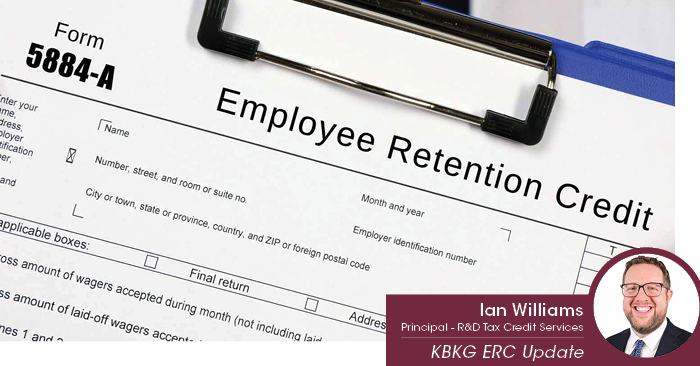Thought Leadership by Ian Williams, Principal | KBKG
As mentioned in KBKG’s last blog post, the IRS provided an update in June surrounding the Employee Retention Credit (ERC), noting that it was planning to disallow high-risk claims and begin catching up on processing low-risk claims this summer. While the IRS did not provide clarity on what they defined as low-risk, they did define high-risk as claims that showed clear signs of being erroneous.
On August 8, 2024, the IRS released another update, announcing they will now begin processing ERC claims filed between September 14, 2023 and January 31, 2024. As previously reported, a bill passed in the House of Representatives in January that would have potentially ended the ERC program on January 31, 2024, but failed to pass the Senate. The IRS has continued to urge Congress to pass that bill or end the ERC program early via subsequent legislation. KBKG continues to monitor the situation for any updates on claims filed after January 31, but for now, the processing moratorium for these claims will likely continue until further notice.
The IRS also provided an update on current ERC processing:
- 28,000 disallowance letters sent out to high-risk claims (see below for additional insight)
- 50,000 valid ERC claims identified as low-risk and lined up for payment processing in the coming weeks
- The IRS anticipates another large block of additional low-risk claims for processing and payment in the fall.
Regarding the disallowance letters, the IRS has begun sending out 105C Letters (claim disallowance) for claims they define as high-risk. While the IRS has not issued any formal communication about these letters beyond their recent news release; KBKG has outlined its insights their potential reasoning and response recommendations below.
KBKG Insight:
Taxpayers have 30 days to respond to these disallowance letters or they will risk having their claim fully disallowed. As KBKG has always recommended with ERC, taxpayers should continually check their mail for IRS notices or these 105C letters so they can quickly respond and sustain the credits they are eligible for. Based on an initial review of these letters, taxpayers who fall into the following categories should be on the lookout for these letters.
- Taxpayers with open claims related to the third quarter of 2021
- Taxpayers that show an overall increase in tax return gross receipts from 2019 to 2021
Many of the letters KBKG has reviewed thus far have the following reason for disallowance listed:
“Our records indicate there were no government orders related to COVID-19 in effect during the quarter(s) you claimed ERC which could have fully or partially suspended your trade or business. Our records also show you do not meet the required decline in gross receipts.”
Given the sheer volume of fraudulent ERC claims the IRS received, taxpayers should not be surprised to see they are using the lack of government shutdown orders as a reason for disallowance, especially given that government orders were more likely to apply in 2020 and early 2021. Furthermore, when the IRS sees an overall increase in revenue from 2019 to 2021, we understand why the IRS would want to review quarterly gross receipts records for those taxpayers.
The flaw in this approach is that the IRS is making disallowance decisions without the facts available to complete a proper review. While their hands were tied due to the lack of information required to be provided on a refund claim via Form 941-X, the IRS appears to be taking the approach of disallowing first and requiring taxpayers to go through a painful appeals process to reinstate potentially valid claims.
For example, while the IRS has access to annual gross receipts records, many taxpayers with an overall increase in gross receipts from 2019 to 2021 still met the quarterly gross receipts reduction requirements (20% reduction in a 2021 quarter compared to a 2019 quarter) to qualify for one or more quarters in 2021.
The IRS did acknowledge in their August 8 update that they plan to adjust their process and filters for determining invalid claims following each wave of disallowances and feedback. They also noted that they will work with taxpayers to get it right in cases where valid claims have been improperly denied.
105C Disallowance Letter Response Information
The IRS taxpayer advocate website provides some additional insight on the 105C letter. The response options available to taxpayers are only listed on some of these letters. KBKG has outlined those details below. The written response options are split into two categories: Formal Protest (claims greater than $25,000) and Small Dollar Case Appeal (claims of $25,000 or less). Items 4 through 6, below, are not required for a Small Dollar Case Appeal, but submitting the additional information may provide a better outcome.
Formal Protest:
- Prepare a written statement that you want to appeal to the Office of Appeals
- List the tax periods or years and disallowed items you disagree with and why you don’t agree with each item
- Provide your name, address, taxpayer identification number, daytime telephone number, and a copy of this letter
- Include a detailed statement of facts with names, amounts, locations, etc., to support your reasons for disputing the disallowance
- If you know the particular law or authority that supports your position, identify that law or authority by providing a legal citation
- Sign the perjury statement below and include it with your written appeal. If your authorized representative prepares the request for an appeal, he or she must sign the statement
- Mail your written formal protest to the address at the top of the first page of this letter.
Statement by individuals or sole proprietors:
“Under penalties of perjury, I declare that the facts present on my written appeal are, to the best of my knowledge and belief, true, correct, and complete.”Signature / Date
Statement by Individual authorized to practice before the IRS:
‘Under penalties of perjury, I declare that I prepared the written statement and accompanying documents. To the best of my knowledge the protest and accompanying documents are true and correct.”Signature of Representative / Enrollment Number / Date
Since this appeals process will be conducted primarily via mail, KBKG recommends providing all of the eligibility proof in the initial response in hopes that this will help resolve the situation quickly. KBKG also recommends making a copy of the submission, using certified mail, and keeping a copy of the proof of IRS receipt.
If the taxpayer does not agree with the appeals decision, they have two years to file suit. Additional information directly from the taxpayer advocate website is included below:
“The IRS will consider your explanation before forwarding your request to the IRS Independent Office of Appeals (Appeals) which will decide if the claim should be allowed. If you don’t agree with the IRS’s decision, you can file suit with the United States District Court that has jurisdiction or with the United States Court of Federal Claims.
The timeframe is generally two years from the date of this letter. This time period continues to run if you decide to ask Appeals to reconsider the decision. Failure to timely file suit means that even if Appeals ultimately concludes that your claim was correct, you will not receive a refund or credit if Appeals reaches its decision after the period for filing suit has expired. Thus, while you can continue to try to resolve the claim with the IRS, as you approach the end of the two-year period specified in the letter, you may want to file a timely suit to protect yourself.
If you’re entitled to a refund, the IRS will send it about six to eight weeks from the time the IRS receives your response and adjusts your account. If the adjustment to your account results in a balance due, the IRS will send you a balance due notice and you should pay the amount you owe by the due date on the notice. If you can’t pay the full amount due, pay as much as you can to limit penalties and interest and visit Paying Your Taxes to consider online payment options. If you need additional assistance, call the IRS at the toll-free number on the top right corner of your notice.”
Conclusion:
Unfortunately, many taxpayers with valid ERC claims will be affected by the IRS’s decision to take the approach of disallowing first and reviewing eligibility facts later. KBKG recommends taxpayers with outstanding refund claims to diligently check their mail for refund checks, and IRS notices or 105C Claim Disallowance Letters. As with all IRS communications, time is of the essence, immediately consulting a tax professional, like KBKG, ensures that valid claims are supported on a timely basis.
If taxpayers have outstanding claims and did not meet the eligibility requirements, consult with a tax professional and review the IRS ERC Withdrawal Program to avoid future compliance issues.
Action Steps:
KBKG provides turn-key tax solutions to CPAs and businesses. By focusing exclusively on value-added tax services that complement your traditional tax and accounting practice, KBKG delivers quantifiable solutions to its clients. Please visit KBKG.com to see which services and solutions benefit you or your clients.
Ian Williams | Principal – Research and Development Tax Credit Services
Ian Williams is a Principal for KBKG, specializing in Research & Development Tax Credits and Employee Retention Credits. Ian spent eleven years at a Big Four accounting firm specializing in R&D tax credits and fixed asset studies across a variety of industries. He has extensive experience in. Read More



